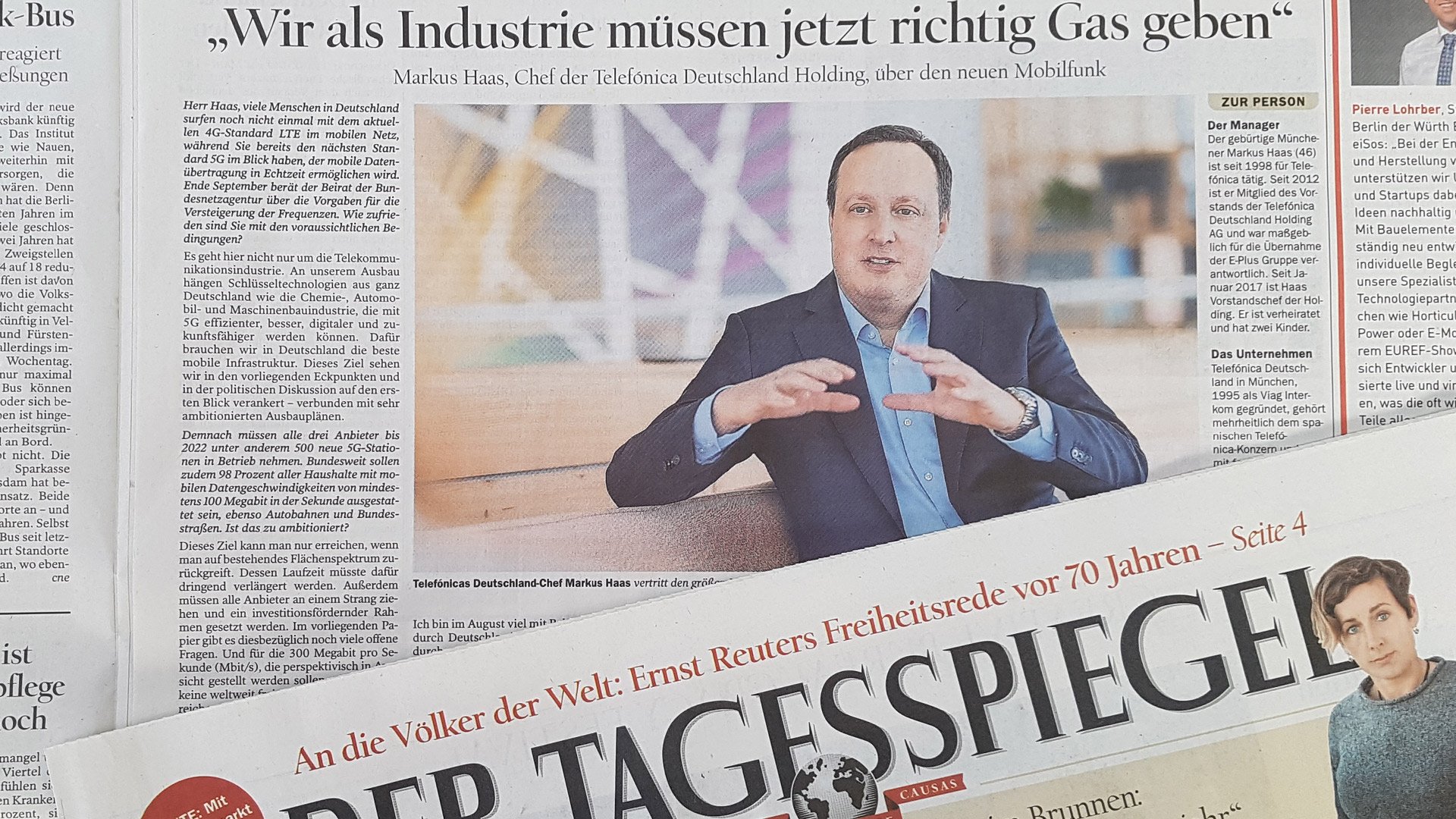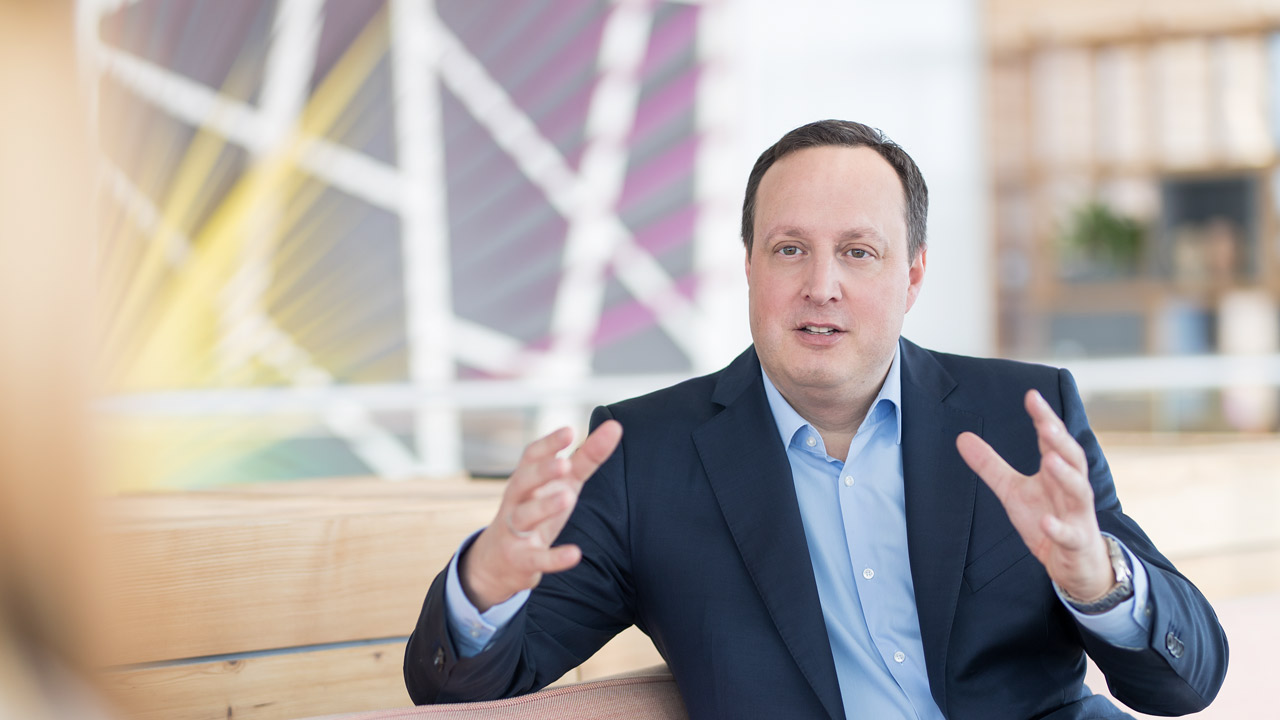08.09.2018
CEO Markus Haas talks to the Tagesspiegel:
“Key technologies throughout Germany are riding on our expansionˮ
In an interview with the German newspaper "Tagesspiegel", Telefónica Deutschland CEO Markus Haas talks about the challenges of the digital infrastructure in Germany as well as the planned allocation rules for the new mobile standard 5G.
We provide an abridged version of the interview here. The full interview appeared in the Tagesspiegel on 8 September 2018.

CEO Markus Haas in an interview with Tagesspiegel
Mr. Haas, many people in Germany are not even using the current 4G standard LTE to surf the mobile network yet, whereas you already have the next standard 5G in your sights, which will enable mobile data transfer in real time. At the end of September the advisory committee of the Federal Network Agency will advise on the guidelines for auctioning the frequencies. How satisfied are you with the prospective conditions?
Haas: This is not just about the telecoms industry. Our expansion is fundamental to key technologies from all over Germany – like the chemical, automotive and machine development industries, which can become better, more efficient, more digital and more fit for the future with 5G. For that, we in Germany need the best mobile infrastructure. We see this objective anchored in the present guidelines and the political discussion at first glance – combined with very ambitious expansion plans.
According to these, all three providers must, among other things, have 500 new 5G base stations up and running by 2022. In addition, 98 percent of all households in Germany are to be equipped with mobile data speeds of at least 100 megabits per second, as are autobahns and main roads. Is that too ambitious?
Haas: This target can only be achieved by reverting to existing low-band spectrum, and for this its lifespan would have to be urgently extended. Apart from that, all providers need to pull together and an investment-promoting framework needs to be set up. In the current paper there are still plenty of open questions on that score. And for the potential 300 Mbit/s in prospect, there are still no globally released frequency ranges, let alone any that will be made available to mobile providers in the next few years.
[…]

Together with Vodafone and Telekom, you want to guarantee nationwide LTE coverage of 99 percent by 2022.
Haas: And we will certainly comply with these requirements if the basic conditions of the 5G allocation are investment-friendly. That’s the condition. Before that, based on previous requirements, we must already supply LTE to 98 percent of the population. In the last 18 years the network operators have invested 60 billion euros in frequencies alone. If we had been able to put that into the infrastructure, like in other countries, we would definitely be much further on in Germany.
What solution do you have for the one percent of the population, often living in rural areas, who still have no coverage?
Haas: Of course it’s our goal to supply all citizens where possible. But I can’t promise that that will happen. It also depends on what is commercially feasible and economically justifiable. But there is much to suggest that we will achieve this goal through infrastructure competition, since the providers don’t have completely overlapping network coverage, so it will then be de facto more than 99 percent. The most expensive part is building and developing a base station. Depending on the location, we’re talking easily several hundred thousand euros per mast. That’s why we’ve already got a joint usage quota of almost 70 percent. It also makes more sense to share a mast with your competitors than to build three right next to each other. We want to step up this and other ideas for cooperation.
[…]

CEO Markus Haas
You have to build at least 1,000 base stations in the next few years. Currently in China they are putting up 460 antenna systems – per day. They’ve got 14.1 mobile phone masts for every 10,000 people there; in Japan it’s even 17.4; in Germany, by contrast, just 8.7. Is Germany not just being left further and further behind?
Haas: In China, of course, they have very different conditions – politically and legally; if you look, for example, at the building safety clearances there, or how cables are laid. Things there are state-organised, pragmatic and therefore they get on with them much quicker. They decide on a site and they start building the next day. Here there are other rules and approval processes. A lot needs to change here so that we can also build more quickly.
What are you calling for?
Haas: In some cases when we want to build an antenna we have a lead time of over a year. If such processes could be completed within six months, that would already be a great help. But it’s already recognised that we need faster approval procedures and the expansion has top priority. But we also need to implement the procedures right through to the regional level, otherwise we won’t be as fast as other countries. I don’t want to be left behind.
[…]